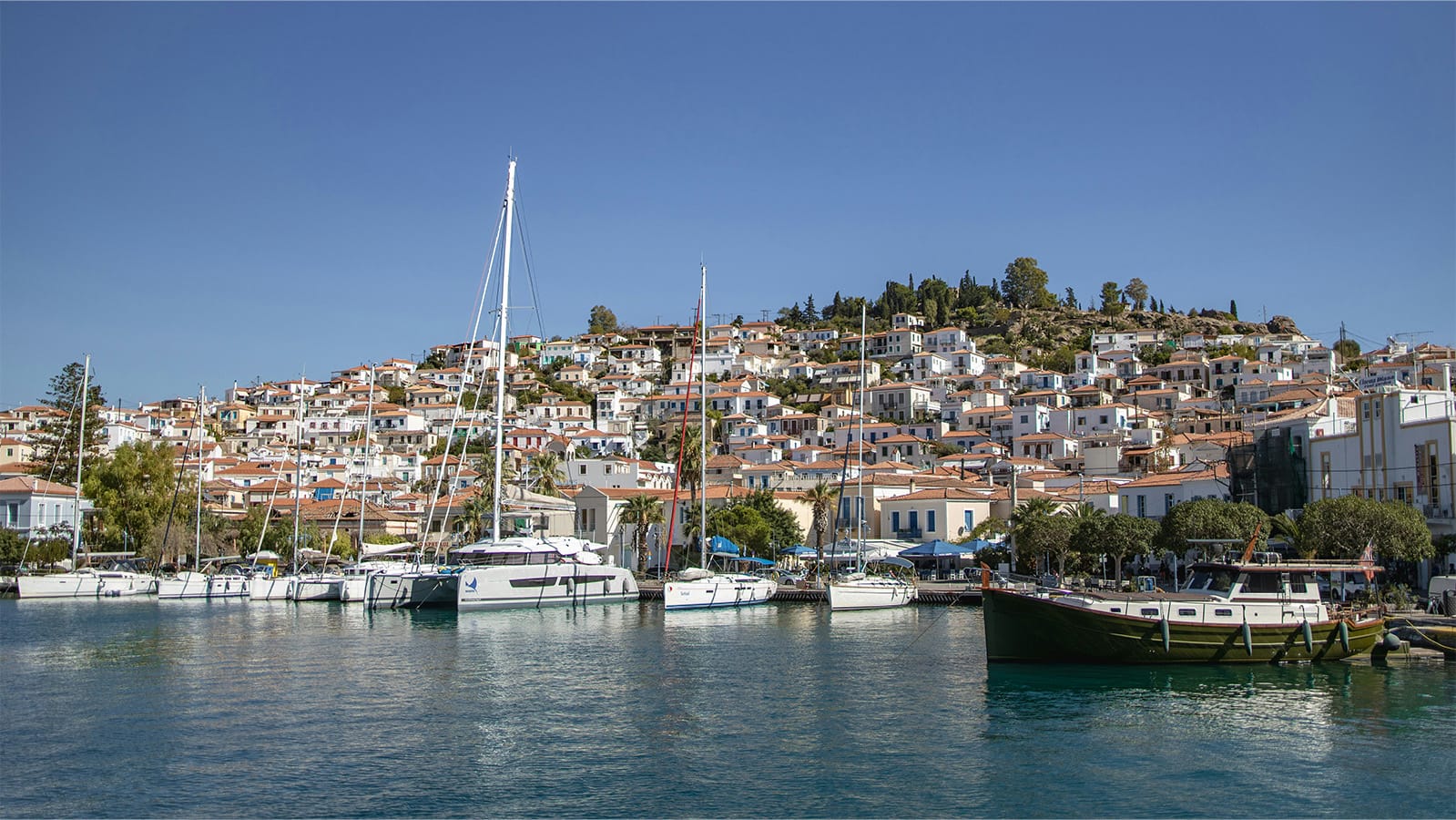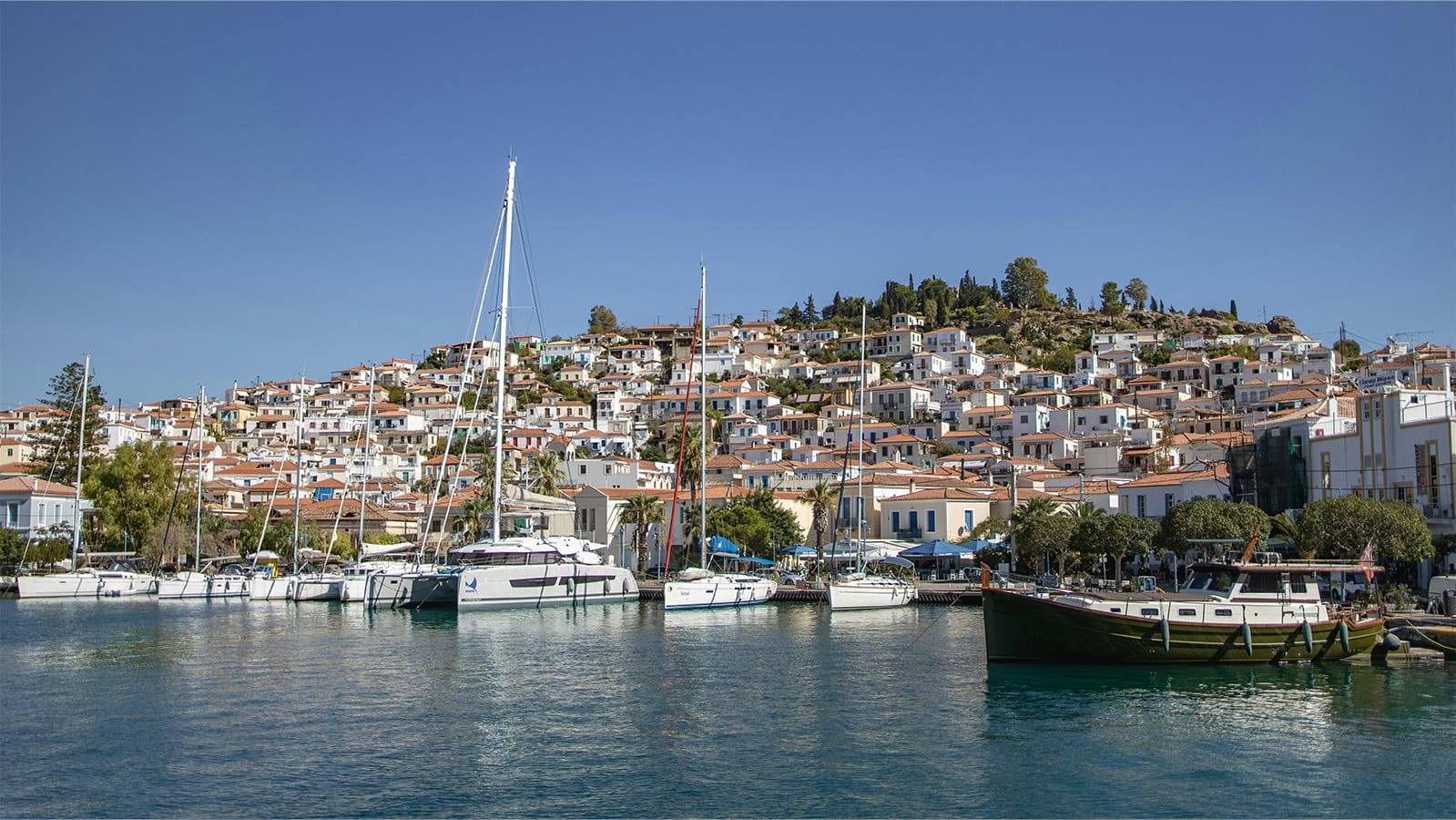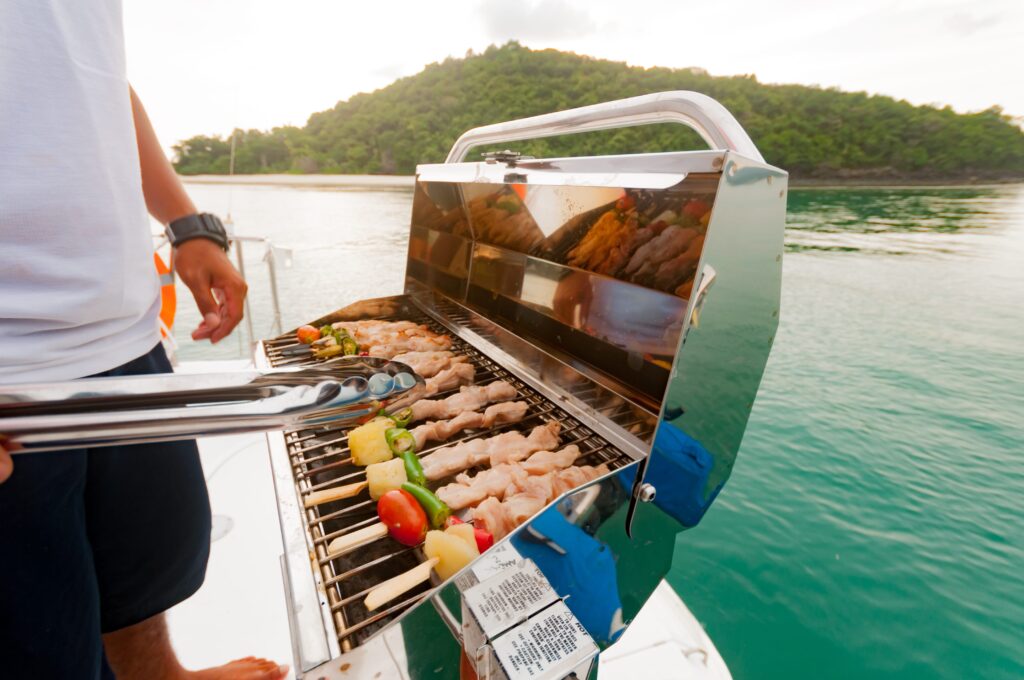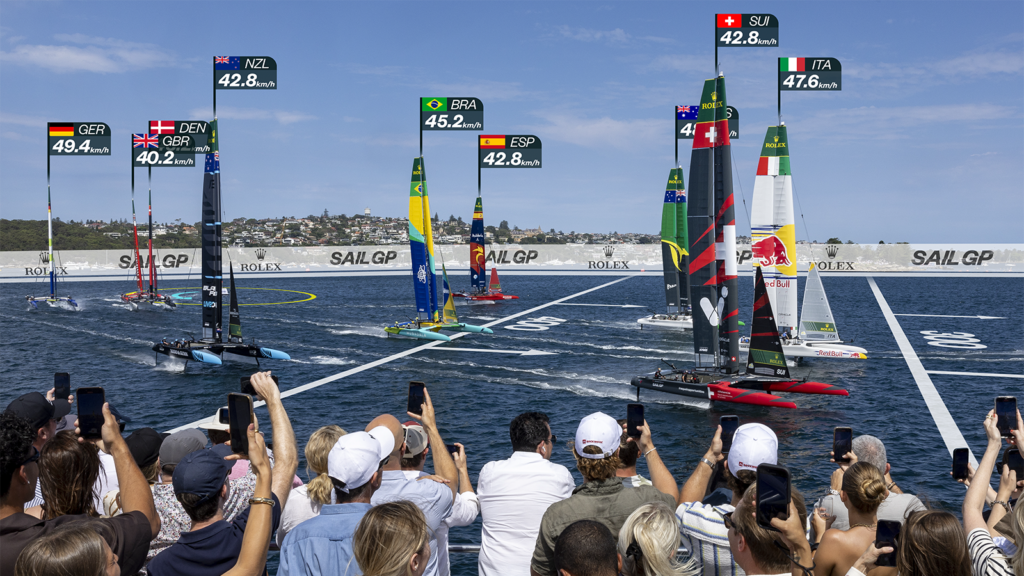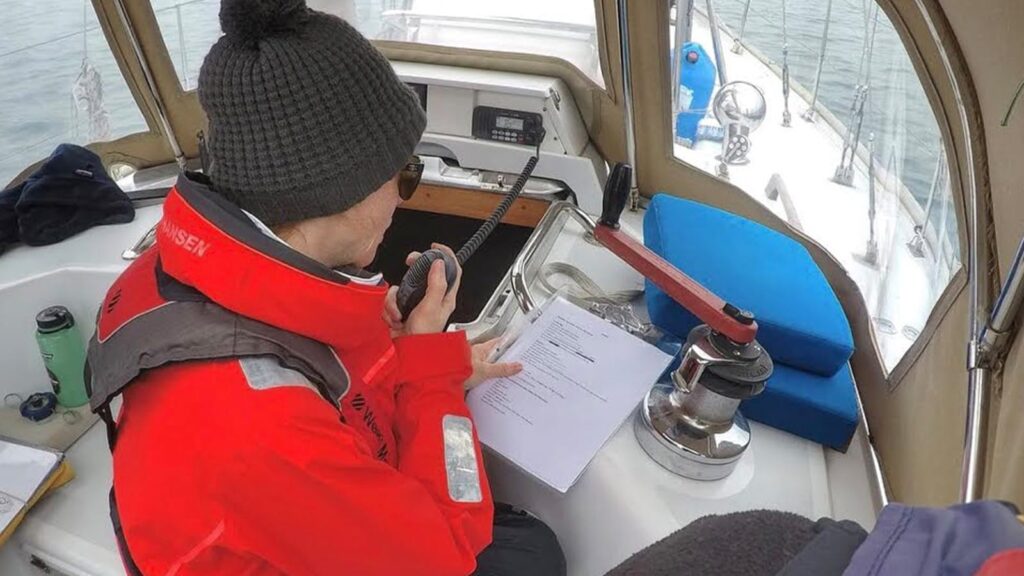By Liam Baker from Athens Sailing Academy
Table of contents
- Mile Building Week – September 2025
- Day 1 – A Delayed Start
- Day 2 – Poros to Naxos
- Night Sailing and Arrival in Paros
- Day 3 – Milos
- Approach to Milos
- Arrival in Milos
- Day 4 – Monevasia, The Peloponnese
- Day 5 – Rest Day
- Day 6 – From Monemvasia to Sampatiki
- Day 7 – Homeward Bound
- Summary
- For More Information
- Join The Discussion
Mile Building Week – September 2025
Each year, our sailing school organizes “Mile Building Weeks” for students. These weeks allow students to log valuable sea miles while also experiencing the realities of offshore sailing. Passages are designed between islands that are beyond the reach of typical charter routes, ranging from 70 to 120 nautical miles. Crews learn to stand night watches, sail in stronger winds and seas, and develop confidence in handling offshore passages.
For this September’s mile builder, the plan was a round trip of more than 450 nautical miles, from our base on Poros to the Dodecanese Islands and back.
Day 1 – A Delayed Start
September 13th arrived, but there was no yacht at our dock. We had chartered a Cyclades 51.5, due to arrive from Athens the previous day. Due to weather delays and earlier technical issues, it never made it on time. Instead, one of our instructors had to sail her down from Athens that morning.
This meant our planned departure was postponed until the following day. In the meantime, the crew slowly assembled on Poros and gathered at Perla Coffee Shop – a relaxed start that allowed everyone to get acquainted.
The crew was an interesting mix:
- Tom, a computer engineer
- Loren, a farmer from Virginia
- Marc, a microbrewer, also from Virginia, with his partner Christine, a lawyer
- Adrianna, another lawyer, from New York
- Laurel, our Head Women’s Instructor
- Jonathan, the yacht’s captain, a retired Royal Naval officer
By late afternoon the yacht finally arrived at our dock. Once the crew stowed their gear, Jonathan conducted a safety briefing and introduced everyone to the yacht’s systems. The outline for the next day’s departure was discussed, and with preparations complete, the crew had the evening free to explore Poros Island before the adventure began.
Day 2 – Poros to Naxos
The crew was up early as we arrived with provisions. Everyone immediately pitched in, loading and stowing supplies with impressive efficiency. In just an hour and a half, we were ready to leave the dock.
Our first passage was ambitious – around 120 miles, with an expected arrival sometime early the next morning. The crew would soon learn one of sailing’s golden rules: there is no such thing as an ETA at sea.
By 10:30 a.m. we were under sail, heading toward the island of St. George, roughly the halfway point between the Saronic Gulf and the Cyclades. Conditions were favorable: a steady 15 knots on the beam, giving us easy reaching conditions. Forecasts, however, warned of stiffer breezes ahead – 20–25 knots with seas of 2–3 meters once we entered the Cyclades. Fortunately, the wind would be mostly on the beam or slightly abaft, making for fast and manageable sailing.
The crew quickly settled into rhythm, steering confidently and trimming sails as needed. Jonathan, our captain, rotated helm duties among the crew, assessing their skills. All proved competent, and with bigger seas ahead, it was clear they would get they chance to improve rapidly.
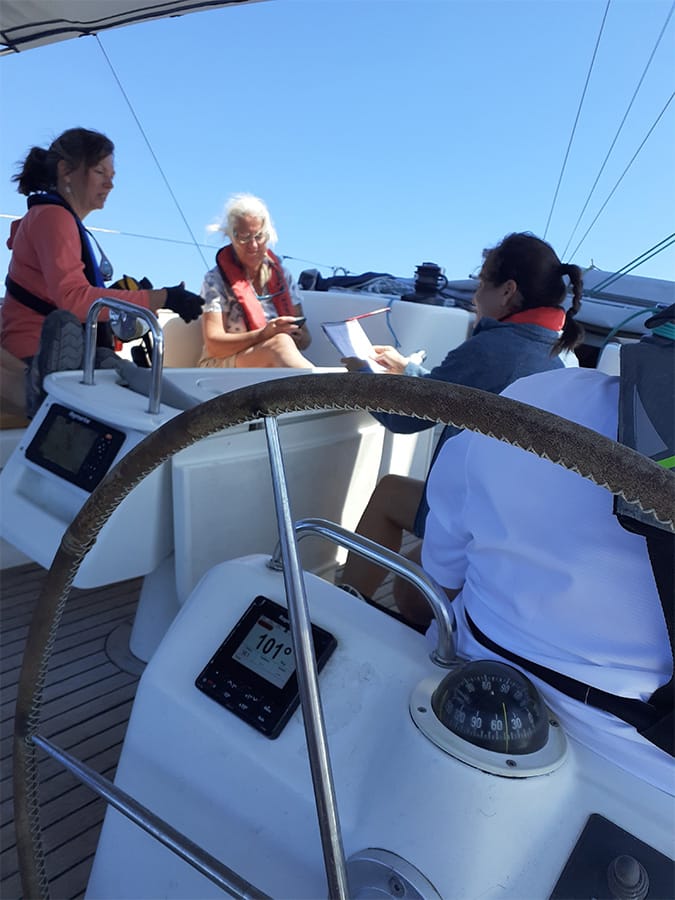
By early afternoon, we passed St. George’s Island where conditions began to change. At 13:00, we entered the Cyclades, and the wind freshened immediately – gusts over 20 knots, seas beginning to build: time for the first reef and a smaller headsail. The crew executed the sail change smoothly, and the yacht powered on, making 9 knots in comfort.
By late afternoon, we rounded the southern tip of Kythnos. Seasickness began to set in. To their credit, no one complained – all stood their watches, determined to push through.
With seas rising and daylight waning, Jonathan challenged the crew to consider their options. Sailing demands flexibility: the skipper must balance weather, crew condition, and destination. It was 17:00, with about three hours of light left. The next 40–50 miles promised more of the same – high winds and heavy seas on a broad to beam reach.
The crew discussed possible harbors:
- St. Stephen’s Bay (Kythnos) – 35 miles to windward, a tough beat.
- Finiakas (Siros) – 45 miles east, a close reach in cross seas.
- Lividia (Serifos) – 45 miles south, a night approach with following seas.
- Paros – 45 miles south-southeast, beam to broad reach, manageable seas, and a well-lit ferry harbor.
After weighing the options, the crew reached a sound decision: sail on to Paros, aiming for a 21:00–22:00 arrival. The harbor offered shelter, good lighting, and easy entry, with ferries providing useful navigation aids.
Jonathan approved. With reefed sails and a clear plan, we pressed on into the night.
Night Sailing and Arrival in Paros
Sailing at night requires a different set of skills. The first is preserving your night vision. At the helm, you steer more by feel than by sight – listening to the wind in the rigging, the rush of water along the hull, and the rhythm of the waves. Wind direction generally holds steady, so maintaining course is relatively easy. The challenge comes from the darkness itself. Sailing into pitch blackness can be intimidating, and helming at night demands confidence and trust in your abilities.
Once land is in sight, navigation becomes easier. Identifying shore lights allows you to steer toward fixed bearings as you close on the port.
Marc took on the role of navigator for our entry into Paros. He quickly picked out the lights on Portes, two rocks that guard the harbor entrance, and then located the red and green harbor entrance lights. His only small miscalculation was distance – the light on Portes Rocks seemed forever distant, even though he had called it at eight miles. At 9 knots, those miles pass more quickly than expected, but even so, closing on a target in the dark can feel like it takes an eternity.
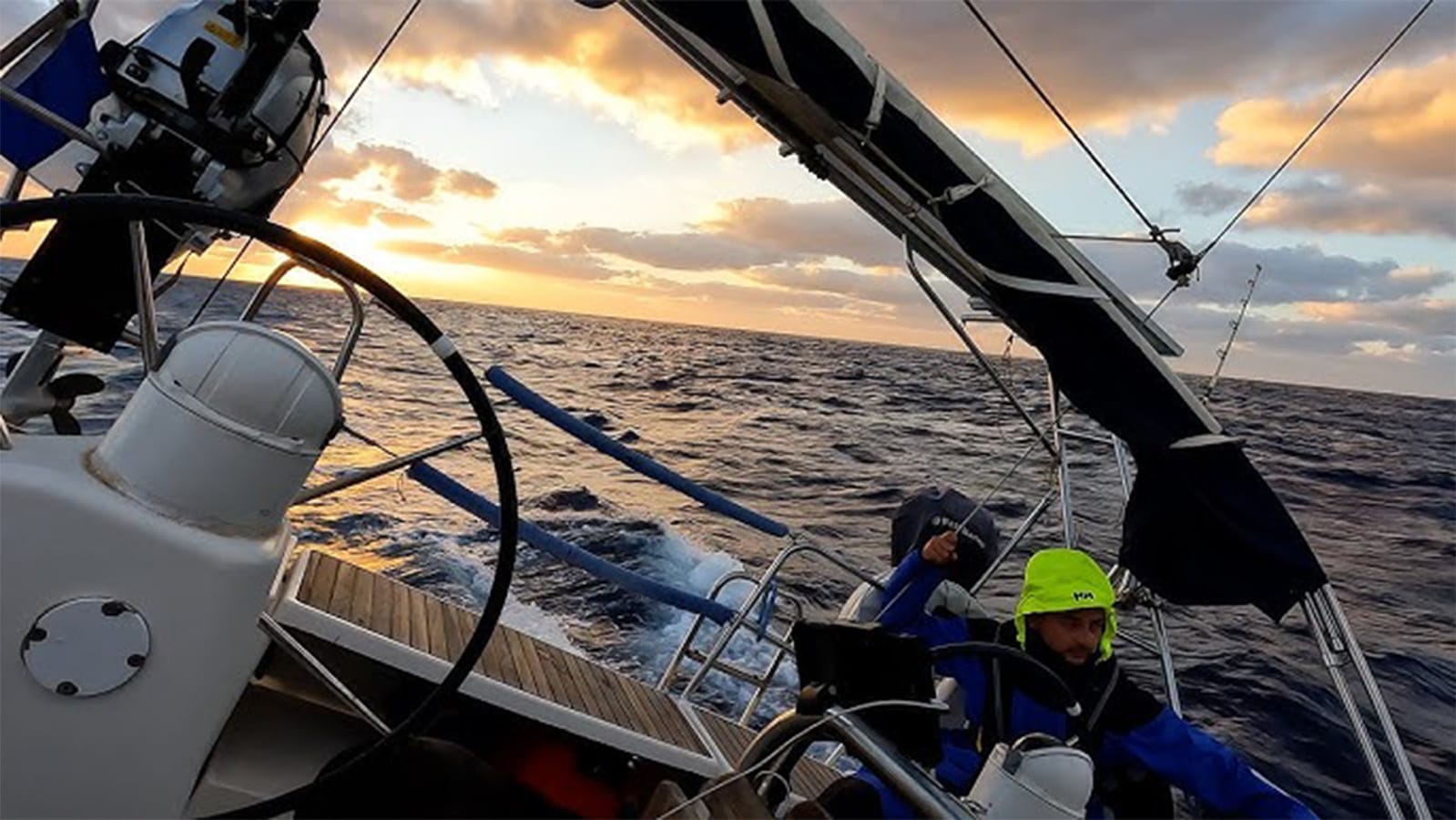
Sunset at sea during the September Mile Builder. The crew holds steady through strong winds and rolling waves on their offshore passage.
At 22:30, we finally dropped anchor in Paros harbor. The crew celebrated with a hearty pasta dinner and meat sauce, washed down with more than a few well-earned beers.
Day 3 – Milos
Arriving at a port in the dark means you never really grasp its beauty until the morning light. When the crew awoke in Paros, coffee in hand, the view gave that first cup an entirely new flavor.
The plan had been to go stern-to on the quay, allowing time ashore before departure. But with rough weather outside, the quay was already packed with catamarans and charter yachts. Instead, the crew loaded into the dinghy and went ashore while Jonathan remained onboard to tend to the yacht and review the next leg of the voyage.
Some maintenance was needed. The batteries had to be charged, but the generator failed to start. The engine, which had only been run for two and a half hours, had already lost an eighth of its oil – a worrying sign and something to monitor closely. The generator would have to wait for repairs at the next port.
Meanwhile, weather reports painted a grim picture further east. Winds in the Dodecanese were expected to rise above 40 knots, with seas building to 3–4 meters – conditions more suited to survival sailing than training. Jonathan made the call: instead of pressing east, we would head south and west toward Milos, about 50 miles away. The passage meant crossing an exposed stretch of water where 25–30 knots of wind and occasional 4-meter waves could be expected. But the angle – a broad reach at around 120° – promised fast sailing.
When the crew returned from town, Jonathan explained the decision. They welcomed it eagerly. A stop at the pharmacy had armed them with seasickness medication, and far from being discouraged by the previous day, they were excited to push on.
At noon, we raised anchor and slipped out of Paros. Along the coast, Christine and Adrianna shared the helm in 20+ knots of breeze on the beam. With one reef in and 75% of the headsail out, they drove the yacht confidently at 8–9 knots.
By the time we rounded the southern tip of Paros, conditions sharpened. The waves grew larger, the wind stronger. Others took a turn at the helm as we bore away onto a broad reach. Now we were running diagonally with the seas, catching surfs that pushed us into double-digit speeds – 10 knots steadily, with bursts of 12 knots as the yacht accelerated down the faces of the waves.
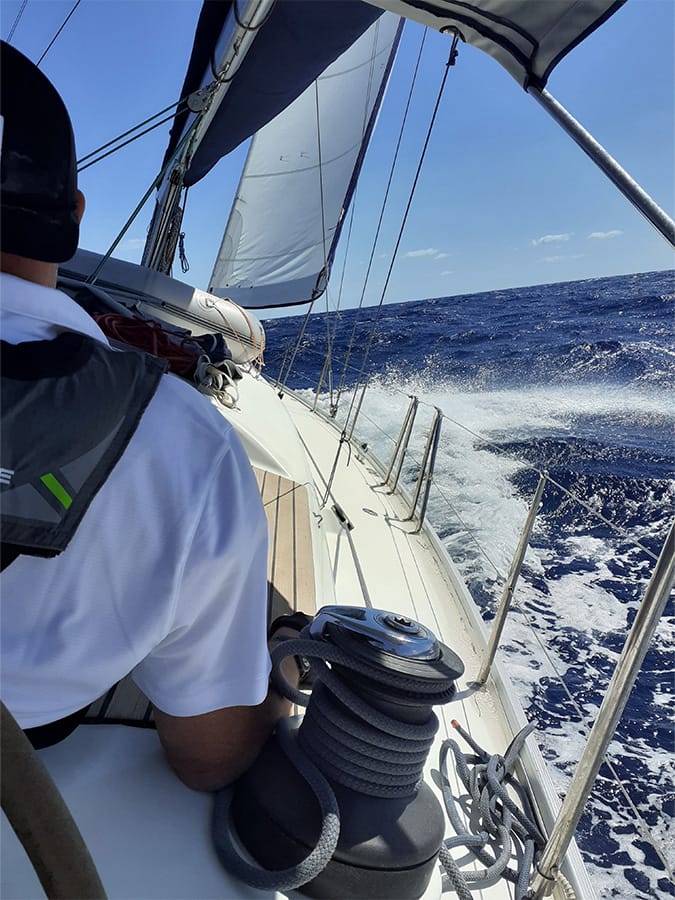
Strong winds whip across the Cyclades coastline, where rugged hills meet the deep blue of the Aegean Sea.
The transformation in the crew was remarkable. Seasickness had vanished, replaced by excitement and confidence. Sandwiches were being made below while others laughed at the helm, thrilled by the ride. Jonathan, watching from the cockpit, noted with pride: this was not the same crew from yesterday.
Approach to Milos
The approach to Milos from the east is never straightforward. Two smaller islands guard the entrance, leaving two possible routes. One option is to sail around the islands – the longer path, but it exposes the yacht to hours on a lee shore in heavy winds and steep beam seas. The other is to slip between the islands, through a gap barely 250 meters wide. In that passage, the seas lie flat, sheltered by the land, but strong gusts funnel off the hillsides, testing both helm and sail trim.
The crew weighed the choices and voted for the more challenging but safer option – the narrow gap.
Tom took the helm first, steering steadily into the passage. Once lined up, he handed over to Marc, who guided the yacht through the flat but blustery channel with calm precision. The decision and its execution proved sound: the yacht slipped safely into the lee of Milos, the crew’s confidence growing with every mile.
Arrival in Milos
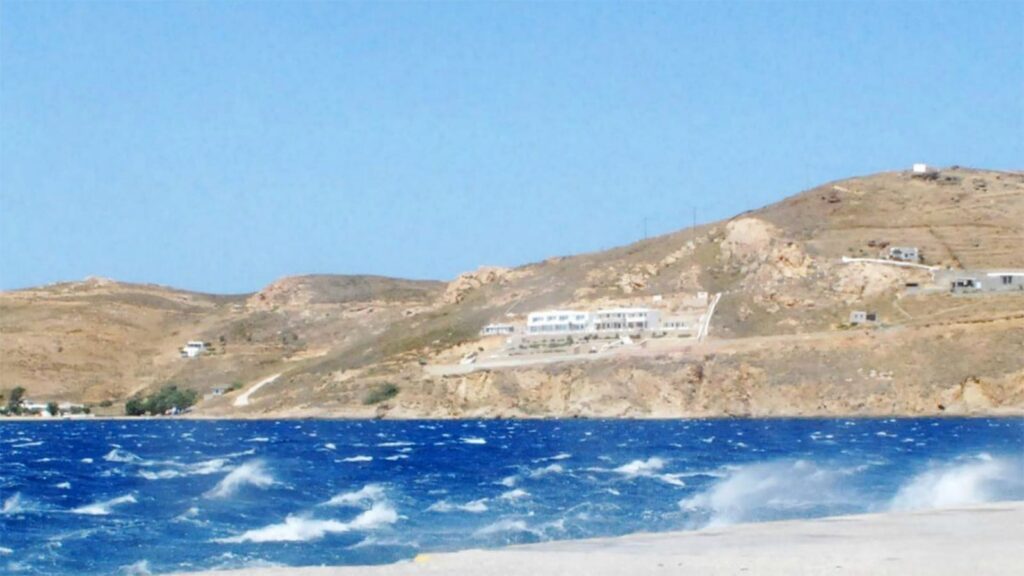
Charging through white-capped waves under clear blue skies towards the Milos Harbor.
Once through the narrow gap between the islands, it was a straightforward reach toward the entrance of Milos harbor. Loren took the helm, steering confidently despite the challenging winds. Only later did we learn that he had sprained his wrist while steering through the heavy seas – a testament to his determination.
The approach to Milos harbor is long, leading into a wide bay with excellent marina facilities. By 18:30 we were Med-moored securely. When we checked the log, we realized we had covered 62 miles in just six and a half hours – an average speed of over 10 knots. Not bad at all for a crew on only their third day of heavy-wind sailing.
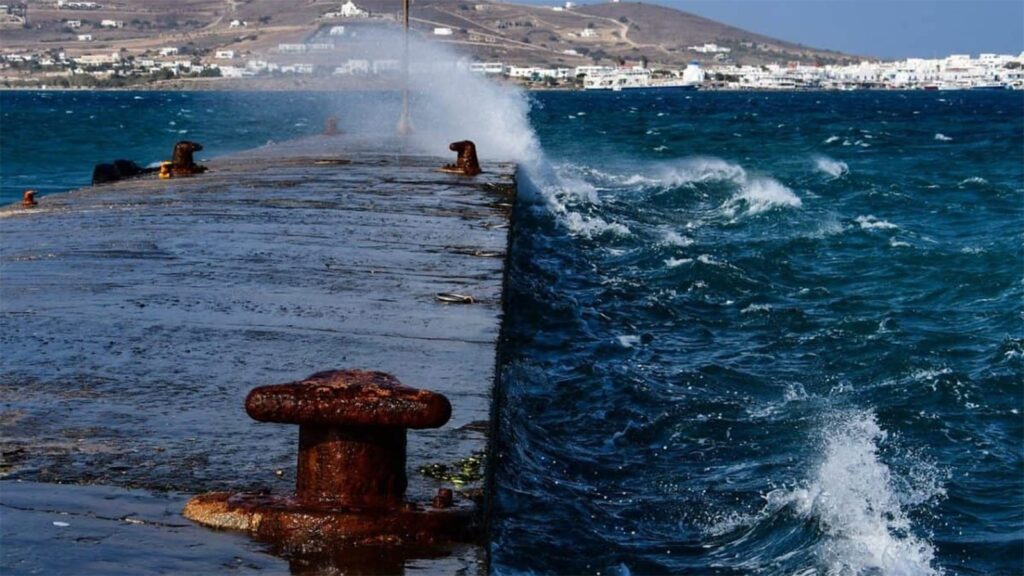
Approaching the Milos Harbor.
Day 4 – Monevasia, The Peloponnese
Our stop in Milos proved especially meaningful for Loren, who is an avid student of Greek mythology. His great hero is Homer, and when he learned that the poet is believed to be buried on Milos, he was overjoyed. A visit to the site was a highlight of his trip. With Monevasia – another ancient site steeped in history – next on our route, he was eager for more.
The weather, however, remained unsettled. The Meltemi was still blowing hard, with 25–30 knots of wind and seas running 2 to 3 meters. Jonathan made the prudent call: rather than pressing further east toward the Dodecanese, it was time to turn westward, begin the homeward journey, and take a day’s rest at Monemvasia.
The passage was about 80 miles, due west from Milos. We departed at 08:00, heading out through the straits. Conditions were much the same as the previous day – strong winds and lively seas – but by now, the crew was accustomed to it, rotating comfortably with 45 minutes each at the helm. With one reef in and 75% of the headsail set, the yacht charged along steadily at 8–9 knots.
By mid-afternoon, the gusts began to ease. At 15:00 we were sailing under clear skies with a steady 20 knots of wind. We rolled out the rest of the headsail and held our speed, enjoying some of the best sailing of the trip.
It wasn’t until the final 20 miles that conditions changed again. The wind dropped to 15 knots, though the sea remained confused and lumpy. The yacht pounded into steep “pothole” waves – sharp, two-meter crests with no backs, dropping the hull hard into the troughs with a loud crash. With boat speed bleeding off, we eventually started the engine for the last two hours.
At 18:30 we tied up safely in Monevasia harbor. Despite the final motor, we had covered 83 miles in 10 hours – impressive progress, and clear evidence of how far the crew had come in just a few days at sea.
Day 5 – Rest Day
Today is a rest day and a chance for the crew to explore the ancient city of Monevasia.
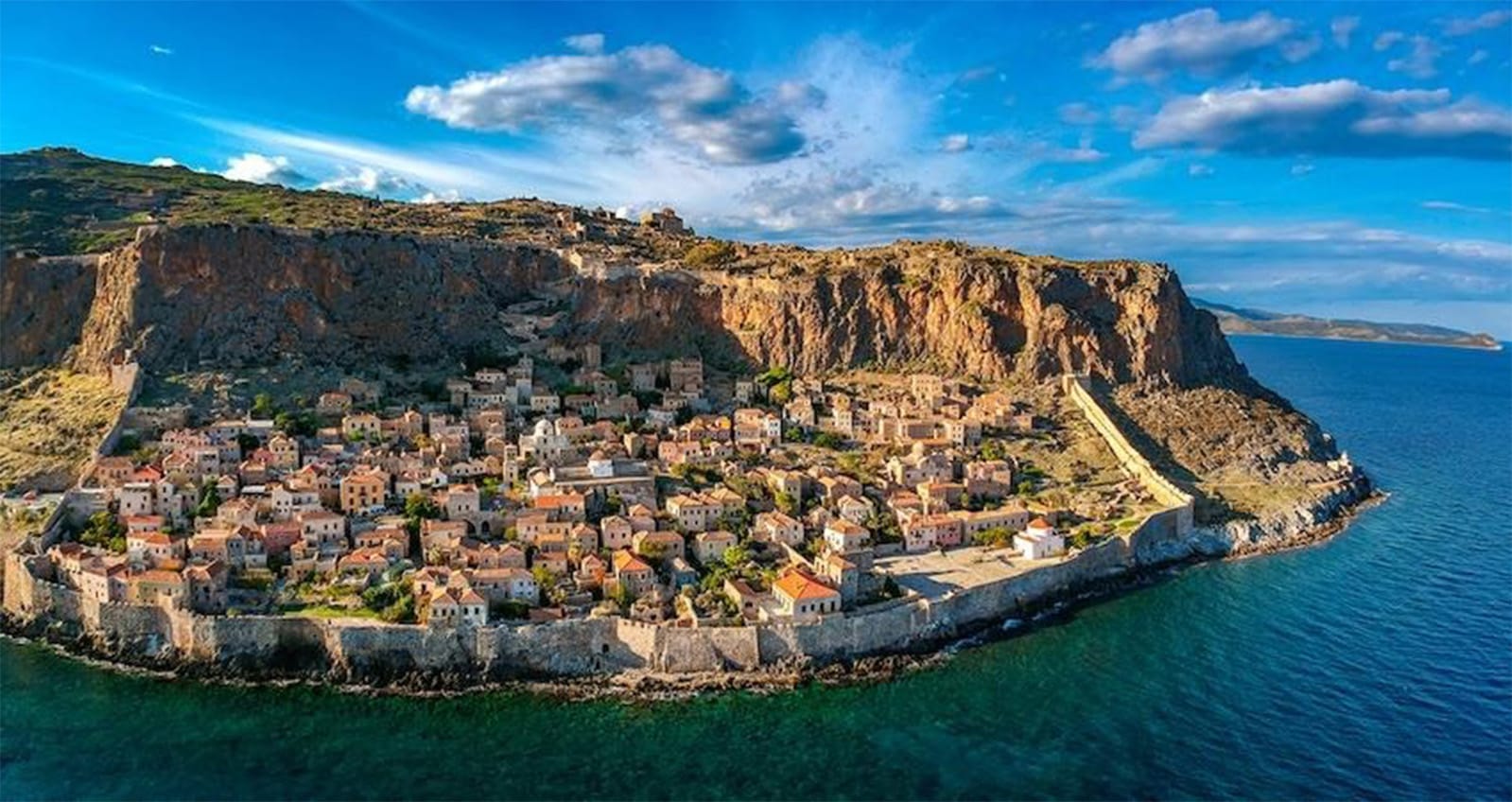
Founded in the sixth century, and thus one of the oldest continually-inhabited fortified towns in Europe, the town is the site of a once-powerful medieval fortress, and was at one point one of the most important commercial centres in the Eastern Mediterranean. The town’s walls and many Byzantine churches remain as testaments to the town’s history.
Day 6 – From Monemvasia to Sampatiki
The crew woke abruptly to the yacht dragging anchor in Monemvasia harbor. The holding there is notoriously poor – soft sand and weed make it difficult for any anchor to bite properly. The culprit, of course, was the return of the Meltemi. After a day of calm sunshine, the wind had returned overnight. Sheltered inside the harbor, we hadn’t felt it while asleep, but by dawn the breeze had built, and suddenly our anchor was dragging.
We had two options: go back out and relay the anchor, or run a spring line further up the dock to hold us off. We chose the latter, giving us time for breakfast, planning, and preparing the yacht for departure.
The day’s goal was Leonidion, birthplace of King Leonidas of Sparta, hero of the stand at Thermopylae in 300 BC. The challenge was the weather: the first 4–5 hours would be hard upwind sailing until we reached the shelter of the northern Peloponnese. There, the winds would ease and, hopefully, the seas as well.
We set two reefs in the main and only 50% of the headsail. Outside the lee of Monemvasia, the Meltemi struck in full force: 25–30 knots with big seas running. Our first tack wasn’t a making tack – we had to hold off from falling too far below the rhumb line before turning onto the better tack northward. After eight miles, we had only slipped half a mile down, so we tacked and settled onto the making tack.
It was hard steering. Helmsmen had to thread the yacht between the waves, avoiding the biggest crests. For three hours we held course, and by the time we tacked again, Monemvasia was far astern. Gradually, the winds eased as we sailed out of the grip of the Meltemi. The seas, however, remained large, slowing us down even as our boat speed fell.
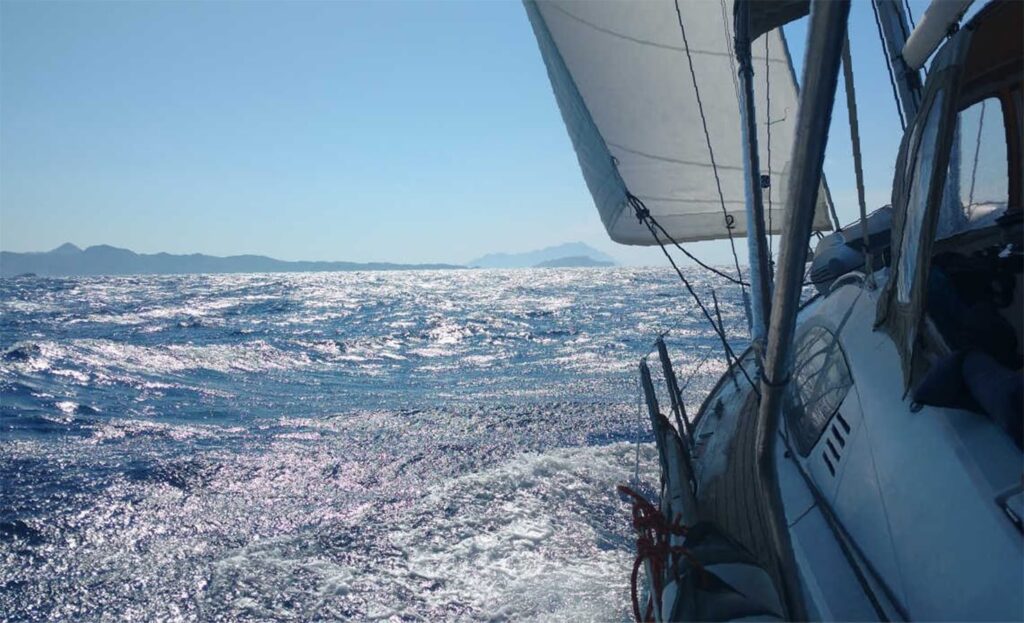
By late afternoon, with 20 miles still to run, we turned on the engine and motorsailed north at 7 knots. Leonidion came into view, but the sight was discouraging – yachts in the harbor were rocking and rolling violently in the surge. It was clearly not a place to spend the night in comfort.
Jonathan, not satisfied, suggested an alternative: Sampatiki, a tiny harbor just 20 minutes further north. With only one tavern, one church, and about 100 residents, it was as quiet as Leonidion was exposed. Thanks to a generous EU harbor grant, it was also beautifully sheltered.
That evening turned into one of the most memorable of the trip. The tavern served fresh snapper, grouper, octopus, and more. The crew feasted for four hours, washed down with wine, laughter, and stories. The bill for seven people came to just €190 – almost unbelievable for such a banquet.
Day 7 – Homeward Bound
The final day was meant to be an easy hop – just 30 miles back to Poros. After what the crew had already endured, it seemed straightforward. Instead, it turned out to be one of the most challenging legs of the trip. What should have been 30 miles became 52 miles sailed, with 11 hours on the water.
We slipped out of Sampatiki at 08:30 and set a course across to Spetsai Island on a close reach. Winds were gusting 15–20 knots with a light sea running. It was only 12 miles, yet helming suddenly became a struggle. Somehow, after six days of improving skills, everyone seemed to forget the basics. Four hours later we were just approaching Spetsai, with the wind freshening to 20–25 knots – now right on the nose.
Threading our way between the islands made the beat even trickier. The crew continued rotating helmsmen every 45 minutes, but what one gained on the helm, the next often gave away. Tacking up Hydra Channel normally takes 2–3 tacks. For us, it took six. At last we reached the Teslavina Cut, leaving only six miles to home.
As often happens, once through the cut, the wind began to die. The final stretch was motorsailed. But just when it seemed the challenges were over, the mainsail halyard failed – the cover stripped from the core, which slipped through the jammer and jammed itself high inside the mast. After much effort, the crew had no choice but to cut the halyard to get the mainsail down. It was not the ending we had hoped for.
Finally, at 19:00, we Med-moored back at our home port. A long, frustrating day, but one that left plenty of stories to tell. Jonathan, ever the good captain, took the crew ashore, placed two bottles of rum on the table, and declared: “These will go bad if not finished in the next two hours.” Spirits rose quickly, and the trip ended on a fittingly cheerful note.
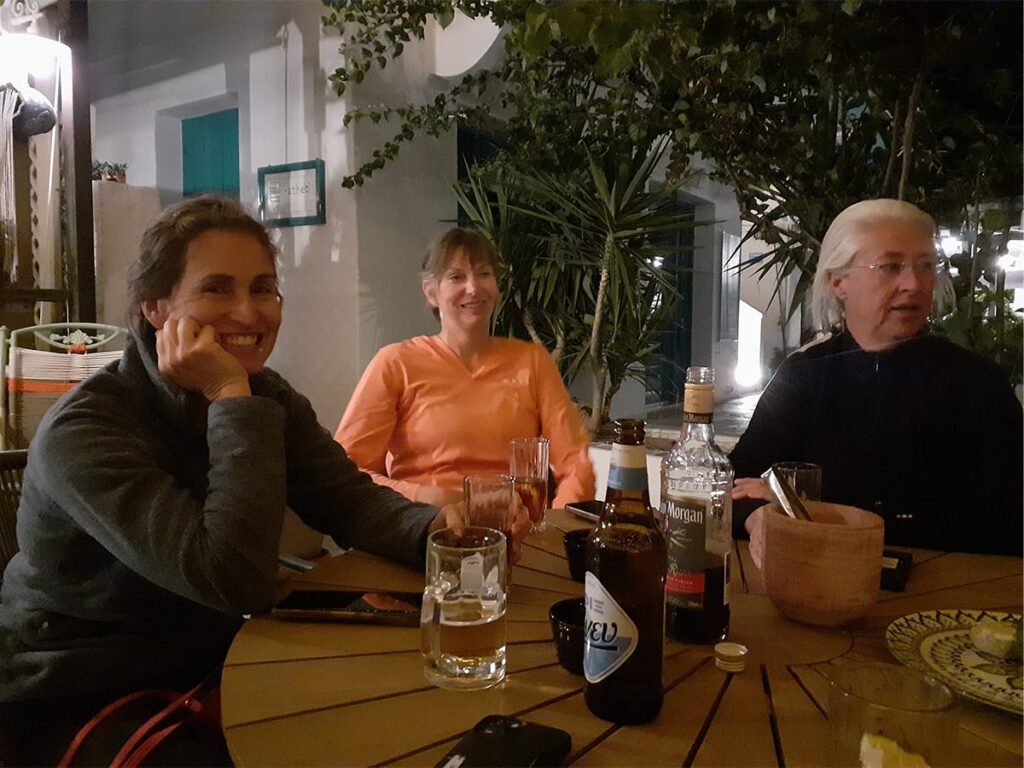
Evening laughter and camaraderie after a long day at sea.
Summary
This was, at its heart, a true mile builder. The goal was to give the crew experience of offshore sailing in all conditions: strong winds, rough seas, night sailing, and harbor entries under pressure. That goal was more than achieved.
What began as a group of strangers – aged 35 to 67, from professions as diverse as farmer, computer engineer, brewer, and lawyer – ended as a cohesive, capable crew. They respected one another, looked after each other, and shared the hardships with good humor. They obeyed safety rules, stood their watches, cooked and cared for each other, passed around seasickness medicine, and learned to sail a big yacht with skill.
By the end of the week, they had sailed more than 450 miles, steered confidently in heavy weather, trimmed sails for speed, navigated challenging passages, and gained both miles and memories that will last a lifetime.
Our school runs Mile Builders twice a year, in spring and fall. If you’re ready to challenge yourself, learn offshore sailing in earnest, and be part of a great crew, we’d be delighted to welcome you aboard for the next one.
For More Information
Join The Discussion
-
Mile Building Week – September 2025
Posted by American Sailing on October 24, 2025 at 1:10 pmEach year, Athens Sailing Academy hosts Mile Building Weeks for sailors ready to go beyond the bay and experience true offshore sailing. The September trip covered more than 450 nautical miles from Poros to the Dodecanese and back—complete with night watches, heavy weather, and lessons learned at every turn. What began as a group of strangers became a confident crew capable of handling whatever the Aegean delivered.
These weeks are about more than logging miles—they’re about building real offshore experience and learning to trust your seamanship.
Would you take on a passage like this or have your before?
Read the full story: https://americansailing.com/articles/september-mile-builder-dodecanese-islands/
Join the next adventure: at athenssailingacademy.com
-
This discussion was modified 1 month, 2 weeks ago by
 American Sailing.
American Sailing.
americansailing.com
September Mile Builder to the Dodecanese Islands
September Mile Builder: Sail Athens’ 450-mile offshore voyage tested skills, built confidence, and forged lasting crew camaraderie.
Belen replied 1 month, 1 week ago 2 Members · 1 Reply -
This discussion was modified 1 month, 2 weeks ago by
-
1 Reply
-
 52
52
 Bronze
Bronze
 New Sailor
New Sailor
Maybe you should consider correcting the title. The route described sails around the eastern Peloponese, nothing to do with the Dodecanese islands.
Log in to reply.

